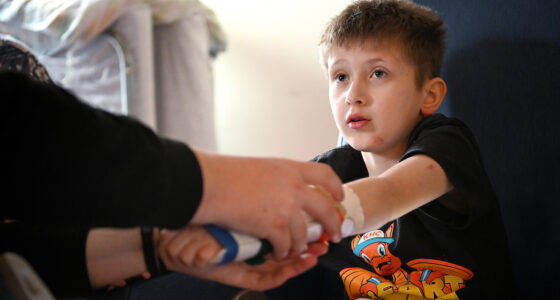
Falls and motor vehicle accidents are the most common cause of trauma injuries in children over the age of 1. Often these accidents result in multiple injuries such as broken bones, back and neck injuries and mild to severe brain damage. These types of accidents may require trauma surgery.
Pediatric trauma surgeons at Riley Children's Health work with a team of pediatric specialists, including doctors in emergency medicine, general surgery, neurosurgery, orthopedic surgery, anesthesiology, intensive care, respiratory care and many specialty nurses to provide lifesaving treatments. The trauma surgeons at Riley Children's treat more than 1,400 children a year. This extensive experience helps us to anticipate what kind of care your child may need and respond quickly.
Severe trauma injuries that require surgery include:
- Head and spinal cord injuries
- Orthopedic injuries (broken bones)
- Abdominal or chest injuries
- Facial trauma
- Ocular & eyelid trauma
What to Expect
What to Expect
When your child sustains a traumatic injury and needs surgery, parents can expect the following steps to happen:
Injury Assessment
- Initial treatment may begin at the scene of the injury to stabilize your child.
- Paramedics may ask you questions about the injury, your child’s general health and any medicines he or she currently takes.
Transportation to Riley Hospital for Children
- You, an ambulance or Indiana University Health LifeLine’s helicopter service will transport your child to the hospital.
- If your child is transported by ambulance or helicopter, the paramedics will communicate with the hospital to give an update on your child’s condition.
Surgical Treatment at the Emergency Room
- When your child arrives at the emergency room, a trauma team is ready to take over.
- Your child’s most severe injuries will be evaluated and treated as soon as possible.
- You will be asked to stay in the waiting area while trauma surgeons and trauma specialists care for your child.
Recovery and Rehabilitation
- Once your child is stabilized and doctors have completed emergency treatment, a doctor with the trauma team will come talk to you about your child’s condition.
- Once your child is stable, he or she may be admitted to the hospital.
- Your child may require the extra monitoring offered in the pediatric intensive care unit (PICU) or cardiovascular intensive care unit (CVICU).
- When your child is well enough, rehabilitation services may begin to help your child regain certain functions and mobility. A physiatrist (rehabilitation doctor) and a team of nurses will evaluate your child to determine if rehabilitation therapy can help with recovery.
Locations
Locations
Locations
In addition to our primary hospital location at the Academic Health Center in Indianapolis, IN, we have convenient locations to better serve our communities throughout the state.
Sort through 4 facilities offering Trauma Surgery care by entering your city or zip below.
Related Stories
Related Stories

Trauma survivor: “I just know my mom is with me right now”
He lost his mother in an accident that left him critically injured, but 9-year-old Chance Charters is recovering, thanks to the love of family and the support of many hospital specialists.
Continue reading
A horrific crash, a remarkable recovery
A 13-year-old athlete couldn’t walk or talk after a serious accident. Now nearly three months later, Matthias Pfister is inspiring his parents and his hospital care team. “He will probably walk out of the hospital as one of the truly most amazing recoveries I have ever seen.” – Dr. Jeffrey Raskin
Continue reading
